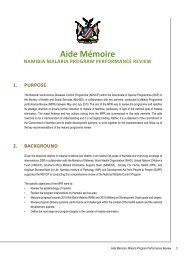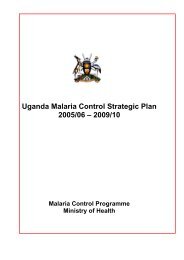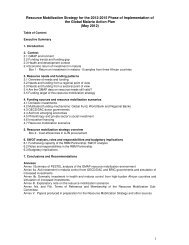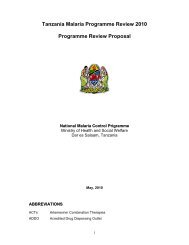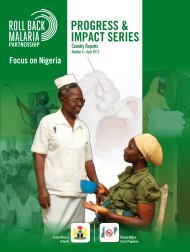Progress & ImPact serIes - Roll Back Malaria - World Health ...
Progress & ImPact serIes - Roll Back Malaria - World Health ...
Progress & ImPact serIes - Roll Back Malaria - World Health ...
Create successful ePaper yourself
Turn your PDF publications into a flip-book with our unique Google optimized e-Paper software.
chapter I<br />
IntroductIon: MalarIa outsIde<br />
of afrIca Is a dIsease of poverty<br />
that poses unIque challenges for<br />
control<br />
<strong>Malaria</strong> exacts a heavy toll in Asia, the Pacific, Americas, Middle East, and Europe. While the<br />
disease burden is heaviest in Africa, outside of Africa there are 51 countries where malaria is a very<br />
real public health problem that threatens many, especially the poor and marginalized. The disease<br />
negatively affects family income due to lost income and payment for treatment. It affects business<br />
due to direct costs of lost production, absenteeism, and prevention and treatment. The biology of<br />
the parasite, the mosquito vectors, and the human population at risk are considerably more diverse<br />
outside Africa, thus presenting a range of unique challenges.<br />
While Africa is widely understood to carry the<br />
major burden of malaria, the disease constitutes<br />
a significant public health problem in 51 countries<br />
elsewhere in the world where it is inextricably<br />
linked with poverty (Figure 1.1).<br />
Poorer populations are more likely to be exposed<br />
to malaria-carrying mosquitoes because they are<br />
more likely to live in rural areas in housing that<br />
offers little protection against mosquitoes and<br />
they are less likely to have access to mosquito<br />
nets or indoor residual spraying of insecticides<br />
(IRS). They also tend to live further away<br />
from health facilities that can offer effective<br />
diagnostic testing and treatment and to be less<br />
able to afford quality treatment.<br />
An episode of malaria reduces the days<br />
worked not only of the infected but of those<br />
that care for them. The Indian Commission on<br />
Macroeconomics and <strong>Health</strong> notes that, in India,<br />
13 household person-days per patient were<br />
lost per episode of malaria. Furthermore, the<br />
commission estimated that the overall monetary<br />
losses to families (income losses together with<br />
treatment expenses) could amount to between<br />
200 and 400 Indian rupees (US$ 3.5 to 7) (1). The<br />
poorest 10% of the Indian population rely on<br />
sales of their assets or on borrowing to pay for<br />
health-care services, reducing a family's ability<br />
to access basic goods and affecting their longterm<br />
economic prospects.<br />
DeFeATIng MAlARIA In ASIA, THe PACIFIC, AMeRICAS, MIDDle eAST AnD eURoPe<br />
17






